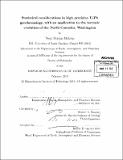Statistical considerations in high precision U-Pb geochronology, with an application to the tectonic evolution of the North Cascades, Washington
Author(s)
McLean, Noah Morgan
DownloadFull printable version (12.51Mb)
Other Contributors
Massachusetts Institute of Technology. Dept. of Earth, Atmospheric, and Planetary Sciences.
Advisor
Samuel A. Bowring.
Terms of use
Metadata
Show full item recordAbstract
The range of geologic problems that may be addressed by U-Pb geochronology is governed by the precision to which U-Pb dates can be measured, expressed as their estimated uncertainties. Accurate and precise knowledge of both the value and uncertainty of an isotopic date are imperative to its correct interpretation. This thesis focuses on quantitatively addressing the large volume of information that contributes to the calculation of published high-precision U-Pb dates. A new algorithm (Chapter 2) outlines the equations that transform measured isotope ratios, along with a host of laboratory and instrumental parameters, into a U-Pb date. The algorithm propagates all known random and systematic uncertainties, resulting in an adaptable framework will remain usable as analytical and computational advances change the main uncertainty contributions. The data reduction and uncertainty propagation algorithm, as well as a new method for calculating weighted means that correctly treats systematic uncertainties, have been incorporated into the open-source software program U-PbRedux. Chapter 3 explores the mechanisms of isotopic fractionation, the largest instrumental correction to measured U-Pb data, using a new linear regression algorithm. The algorithm rapidly regresses a straight line through large datasets in multiple dimensions using a novel simplification to the maximum likelihood objective equation, and is used to demonstrate that Pb undergoes mass-independent fractionation in the source of a thermal ionization mass spectrometer. Chapter 4 addresses the largest source of systematic uncertainty considered when confederating datasets from different labs, the calibration of the tracer used for isotope dilution. The calibration assumes only first-principles mass and purity measurements traceable to SI units, then defines a measurement model that utilizes >105 measurements in a series of overdetermined inverse problems to estimate the tracer isotopic composition. The result is a reduction by a factor of almost four in the tracer uncertainty contribution to a U-Pb date. In Chapter 5, I use the new algorithms to explore regional geology. High-precision U-Pb dates from the metamorphic core of the North Cascades and from ash beds in three fluvial basins that flank it show that Eocene magmatism, solid-state deformation, and exhumation of the metamorphic core are coincident with rapid basin subsidence.
Description
Thesis (Ph. D.)--Massachusetts Institute of Technology, Dept. of Earth, Atmospheric, and Planetary Sciences, 2012. Cataloged from PDF version of thesis. Includes bibliographical references (p. 173-186).
Date issued
2012Department
Massachusetts Institute of Technology. Department of Earth, Atmospheric, and Planetary SciencesPublisher
Massachusetts Institute of Technology
Keywords
Earth, Atmospheric, and Planetary Sciences.